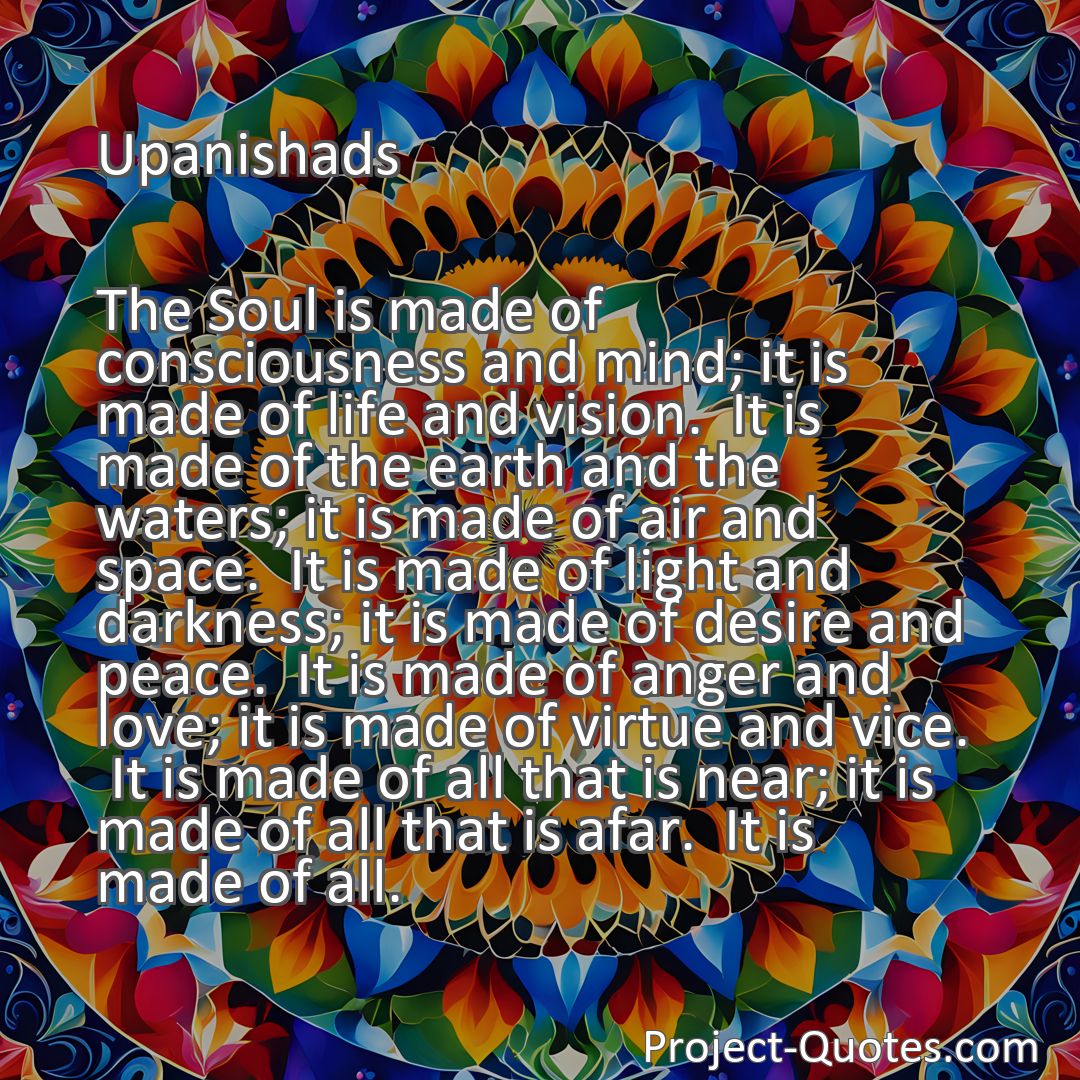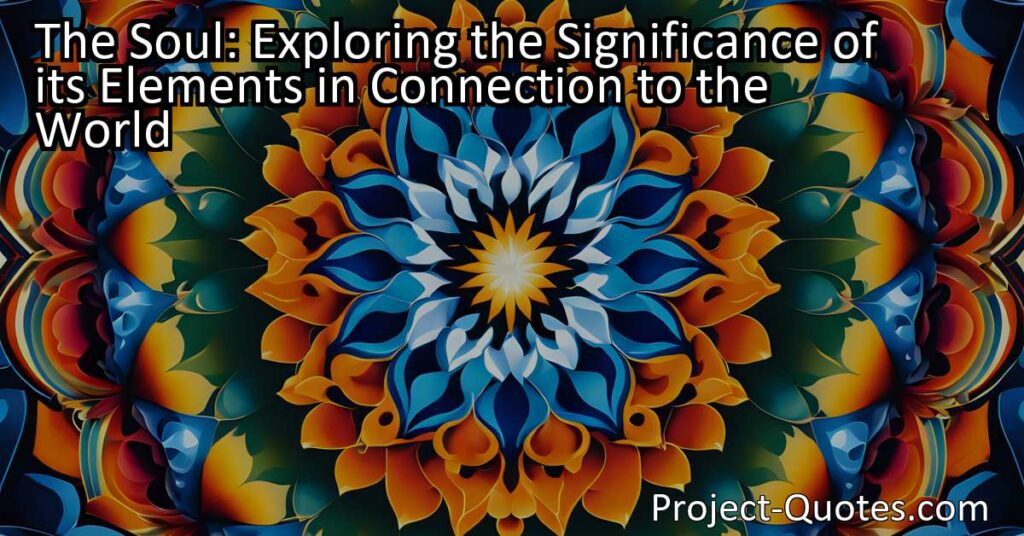The Soul is made of consciousness and mind; it is made of life and vision. It is made of the earth and the waters; it is made of air and space. It is made of light and darkness; it is made of desire and peace. It is made of anger and love; it is made of virtue and vice. It is made of all that is near; it is made of all that is afar. It is made of all.
Upanishads
The Soul: Exploring the Significance of its Elements in Connection to the World The concept of the soul has fascinated people for centuries. In examining the elements that make up the soul, such as consciousness, mind, life, vision, and more, we gain a deeper understanding of ourselves, our place in the world, and the interconnectedness of all things. By exploring these soul elements, we can embark on a journey of self-discovery and fulfillment.
Table of Contents
- 1 The Soul is made of consciousness and mind; it is made of life and vision. It is made of the earth and the waters; it is made of air and space. It is made of light and darkness; it is made of desire and peace. It is made of anger and love; it is made of virtue and vice. It is made of all that is near; it is made of all that is afar. It is made of all.
- 2 Upanishads
- 3 Meaning of Quote – The Soul is made of consciousness and mind; it is made of life and vision. It is made of the earth and the waters; it is made of air and space. It is made of light and darkness; it is made of desire and peace. It is made of anger and love; it is made of virtue and vice. It is made of all that is near; it is made of all that is afar. It is made of all.
- 4 Freely Shareable Quote Image
- 5 Related
Meaning of Quote – The Soul is made of consciousness and mind; it is made of life and vision. It is made of the earth and the waters; it is made of air and space. It is made of light and darkness; it is made of desire and peace. It is made of anger and love; it is made of virtue and vice. It is made of all that is near; it is made of all that is afar. It is made of all.
The concept of the soul has been a topic of contemplation and speculation for centuries. People across different cultures and belief systems have tried to understand the essence of the soul and its connection to the world around us. In the quote provided, it suggests that the soul is made up of various elements like consciousness, mind, life, vision, earth, waters, air, space, light, darkness, desire, peace, anger, love, virtue, vice, and everything that exists both near and far. Let us delve deeper into each of these elements and explore their significance in relation to the soul.
Consciousness and mind are two fundamental aspects of the soul. Consciousness refers to our awareness and ability to perceive the world around us, while the mind encompasses our thoughts, emotions, and reasoning abilities. These aspects are deeply interconnected and shape our understanding of ourselves and our place in the universe.
Life and vision represent the existence and perspective offered by the soul. Life encompasses our experiences, growth, and interactions, while vision refers to our ability to perceive and interpret the world. The soul’s connection to life and vision highlights its role in shaping our perception, understanding, and purpose in life.
The mention of earth, waters, air, and space points to the soul’s connection to the natural world. The earth symbolizes stability and grounding, while waters represent emotions and fluidity. Air represents breath, communication, and movement, while space symbolizes expansion and possibility. The inclusion of these elements suggests that the soul is intimately connected to the environment and influenced by its various forces.
Light and darkness, as opposing forces, represent duality within the soul. Light signifies illumination, clarity, and enlightenment, whereas darkness represents the unknown, mystery, and the depths of the soul. The presence of both light and darkness in the soul emphasizes the existence of balance and contrast, enabling personal growth and self-discovery.
Desire and peace represent two contrasting states of the soul. Desire encompasses our wants, ambitions, and passions, driving us towards growth and achievement. On the other hand, peace represents serenity, contentment, and inner calm. The coexistence of desire and peace in the soul demonstrates the importance of finding a harmonious balance between pursuing goals and finding fulfillment in the present moment.
Anger and love reflect the emotions that shape our interactions and relationships. Anger represents frustration, dissatisfaction, or righteous indignation, while love embodies compassion, empathy, and connection. The soul’s composition of anger and love suggests that these emotions play a significant role in our personal growth, understanding of others, and our ability to form deep and meaningful connections.
Virtue and vice represent the moral compass of the soul. Virtue encompasses qualities such as honesty, kindness, and integrity, while vice refers to negative traits like greed, selfishness, and deceit. These opposing forces within the soul reflect our capacity for both good and evil, highlighting the importance of cultivating positive qualities and striving towards moral excellence.
The soul being made up of all that is near and all that is afar suggests that it is not limited by physical proximity or distance. It encompasses the entirety of existence, both tangible and intangible. This inclusiveness reflects the interconnectedness of all things and implies that the soul is not confined to the boundaries of the physical body but extends its influence beyond visible boundaries.
In conclusion, the quote provides a rich tapestry of elements that comprise the soul. From consciousness and mind to life and vision, from earth and waters to air and space, from light and darkness to desire and peace, from anger and love to virtue and vice, the soul is portrayed as a complex and multifaceted entity. It encompasses the entirety of our being and connections to the world around us. Exploring and understanding these elements can deepen our self-awareness, facilitate personal growth, and foster a greater sense of connectedness with the world. Embracing the intricate nature of the soul can guide us on a path of self-discovery and fulfillment.
I hope this quote inspired image brings you hope and peace. Share it with someone who needs it today!


